
E. M. Bazelyan, DEA, professor;
Power Engineering Institute to the name of G.M. Krzhizhanovsky , Moscow;
recognized Russian expert in the field of grounding and lightning protection.
Direct lightning strike is a pretty rare event. In Central Russia, 1 km2 of a flat ground surface receives only 3 to 4 lightning discharges per year. On average, not more than one lightning strike gets into a lightning arrester with a typical height of 30 m for 10-15 years of operation. If you are lucky, your unprotected cottage will not get a direct lightning strike during your entire life. However, when you protect high or large facilities, e.g. TV towers at the plant or residential territories or air power lines, you have to deal with the real danger of a direct strike. Here, the probability of direct exposure of lightning current is significant. The lightning may strike such facilities every year or even several times during a storm season.
However, even if you live in a small house, you should not forget about lightnings. The danger of the direct strike is low, although the direct strike is not a single weapon of the Prophet Elijah. According to the Slavic legends, he is the one who commands lightnings.
Nature of electromagnetic interference
Several years ago, during a dinner, the dining room of my small wooden house was blinded by a lightning flash. The storm discharge followed without a delay: there was about 100 to 150 m to the strike point. The TV turned off and the microwave oven indicator blinked off as well.
I have been living in our street for many years. I walked around my neighbours to evaluate the damage. There were no protection means in any house. I promised to my family that I would install them in the nearest future when I have some free time. Probably, the lightning was easy on me as a specialist. Only the microwave oven and the TV antenna have burnt out. My neighbours' losses were more significant: up to 11 electric devices in a house located at the distance less than 100 m from mine. I can hardly think of any better explanation of electromagnetic interference.
Many books were written about the life of a well-known English researcher Michael Faraday. He is a self-learning scientist, a self-made man, who started his work as a laboratory assistant for Humphry Davy. The books about Faraday contain many legends, so it is sometimes difficult to tell the truth from truth-like fantasies. But there is one point that causes no doubts. Faraday knew that the electric current creates a magnetic field that deviates the compass needle, and he was certain that an opposite event exists, i.e. the magnetic field should create the electrical current. They only had to learn how it happens. Many years had been spent in solving this. A truth-like legend says that, in the Faraday's laboratory, on one table, a hollow coil with a winding was placed where he could insert a permanent magnet, while on another table, the device to measure current in the coil was located. After inserting the magnet, the researcher went to another table to see whether the current appeared. But there was no current. To be more precise, there was already no current. It appeared only when the magnet was entered or removed, i.e. when the magnetic field in the coil changed.

Probably, the legend about two devices is not really accurate. Michael Faraday solved the problem by establishing the electromagnetic induction principle, and thus took humankind to the electricity age. But lightning specialists finally learned about its remote electromagnetic effects.
Evaluation of the electromagnetic interference level
Most advanced microelectronic devices cannot withstand such interference.
The performed estimate is also interesting in another respect. Its result essentially cancels standalone lightning arresters. They are described in RD 34.21.122-87 as a mandatory protection means for explosion hazardous facility. The fire service does not allow direct lightning strikes to it. Arguments are simple and clear. Almost all modern building structures contain reinforced concrete. Its metal reinforced bar is not usually welded but rather secured with a wire or laid with overlaps. Their contacts are not secure in this case. In direct lightning strike, the current flows along the reinforced bar and can highly likely meet a "bad" contact that may cause sparking. A spark in an explosive volume is completely unacceptable. A standalone lightning arrester supposedly prevents this bleak event.
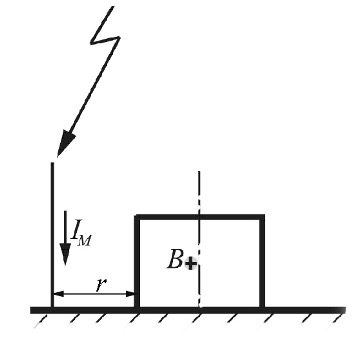
Does it really? The performed calculation provides a negative answer. According to the Guidelines RD 34.21.122-87, the minimum distance from the standalone lightning arrester to the protected explosive facility can be just 3 m. It means that the electromagnetic interference obtained above should be increased by 3.3 times. The voltage exceeding 12 kV can easily ensure a spark gap breakthrough with the length of several millimeters. This is sufficient enough to explode the gas mixture. The circuit where the EMF of the magnetic induction occurs may be composed of any wires, e.g. supports of a ladder or even accidentally unloaded steel reinforcement bars. There is also no problems with a spark gap. Rubber spacers of the ladder base, a layer of rust on reinforcement bars, accidental soiling or any other insulation coating are suitable for this purpose. As you can see, it is not an accident that Guidelines SO-153-34.21.122-2003 do not even mention the advantages of standalone lightning arresters.
Air power line wires form just about the largest circuit. In a conventional design, bare wires of the 0.4 kV line are located at the distance of Δd ≈ 0,4 m from each other. A circuit of several square meters is formed with the line length of several hundred meters. The estimate of the induced EMF in this circuit is not as simple as it seems. First, with distance from the lightning strike, the magnetic field of its current is reduced in an inverse relation to the distance. This must be considered in the calculation. Second, the current which forms dangerous lightning effects is formed in its channel after the contact with the ground surface or an above-ground facility. It is caused by neutralization of the lightning charge and is manifested as the wave propagation which, in its main stage, goes from the ground to the thundercloud with a velocity compared to the light velocity. The current wave, by fading and deforming, progressively fills in the lightning channel to thereby form an electromagnetic field in space. It is hardly reasonable to add such a complex current source varying in space and time into this approximate estimate. The more so, the article is intended only to roughly estimate the electromagnetic interference level. It is easier and more reasonable to evaluate the interference from above by using for this instant filling of the lightning channel by the current, and add the maximum steepness of the current pulse rated in the regulatory documents to the calculation (Ai = 2х1011 A/s for protection level I). Considering the assumption made, for the EMF of the magnetic induction in the line having the length of l, the following formula can be obtained:

wherein r is a minimum distance of the lightning strike point to the air line. When creating a formula, it was supposed that the lightning channel is vertical while the circuit formed by line wires is crossed by the lightning magnetic flux at a right angle. The calculation results using formula (2) are provided in the figure for the 200 m line depending on the minimum distance to the lightning strike r of the lightning.
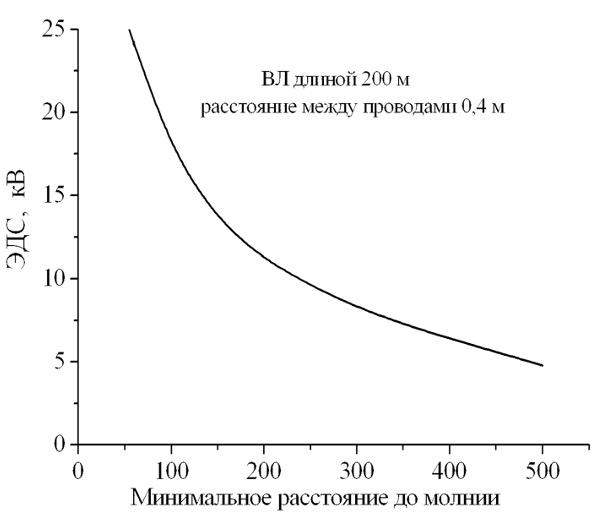
ЭДС, кВ - EMF, kV
Минимальное расстояние до молнии - Minimum distance to the lightning
ВЛ длиной 200 м - 200 m APL
Расстояние между проводами 0,4 м - Distance between the wires 0.4 m
You can easily see that, lightning strike interference is dangerous for modern microelectronic equipment even at the distance above 500 m from the conventional air power line where the magnitude of the induced voltage exceeds 5 kV.
How can we limit the electromagnetic interference?
Formula (1) is also interesting in that it indicates the efficient way to reduce the electromagnetic interference. If you cannot reduce the line length, the distance between the wires Δd is quite possible. And the interference value is directly proportional to this parameter. In Russia, an increasing amount of the 0.4 kV lines are provided with the SIP wire. Actually, this is not a wire but rather a cable with insulated conductors suitable for securing at power line supports instead of conventional bare wires. Its internal steel wire does not allow the wire slag even in case of sufficient mechanical load.
The calculation formula (1) is great, and moreover, its usefulness can be noted also to search for the efficient reduction of interference in internal circuits of the protected structure. There, it is also worth reducing the electrical circuit area penetrated by the magnetic flux from the lightning current, but it is also important to reduce the magnetic flux itself. To do this, the lightning current must be directed to the ground along the maximum number of paths by distributing it along the maximum number of current collectors, including natural ones. We have already told during ZANDZ webinars. on the efficiency of this method to reduce the electromagnetic interference. As an example, the figure demonstrates the magnetic environment inside the building having dimensions of 50 x 50 m, with various numbers of current collectors. In the case of a single current collector, the magnetic field strength at the distance of about 1 m from it is close to 0.2 A/m, while when using as natural current collectors, the metal reinforcement of glass units with the spacing of 2 m, it reduces there for more than 2 orders of magnitude, respectively weakening the electromagnetic interference. The effect becomes even more full with the distance of the internal utility from the current collector. This is a very efficient mean, and, which is the most important point, almost free of charge.
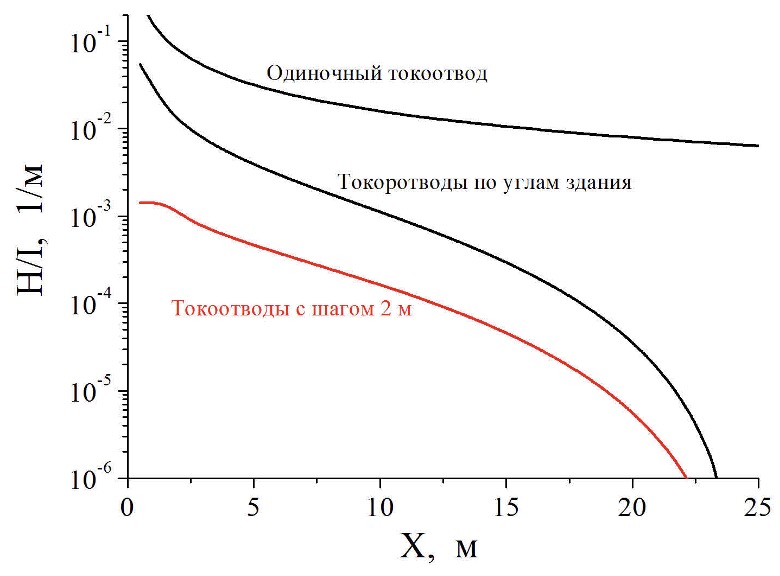
Nature of the electrostatic interference
The lightning current as well as its charge may because a source of electromagnetic interference. Quick changes in the electrical field of the lightning may cause rapid charge changes induced at a wire. Significant current is thus created through the conductor ground terminal. The voltage drop from this current at the grounding resistance will be taken as an electrical component of the induced surge.
Now, imagine the electrical conductor with the capacity of C located over the ground at the height of Δh. This may be a horizontal wire (e.g. antenna), a metal body of a device or a structure. On its surface, the downward lightning leader electrical field as a result of electrostatic induction will induce the charge of
ΔQ = ΔhEC,
where C is the electrical capacity of the conductor. After the lightning strike to the ground, when the charge of its channel is neutralized and the electrical field disappears, the induced charge flows from the wire to the ground through the grounding resistance of Rg.The current from the draining charge will create a voltage drop at the conductor relative to the ground. This may be a sufficiently high value. If, e.g., the conductive facility having the capacity of C = 1000 pcF (the wire about 100 m long) is suspended at the height of Δh = 10 m in the field E= 100 kV/m, the induced charge will be equal to ΔQ = 10 х 105 х 10-9 = 0,001 C. During the main lightning stage, upon neutralization of the ground part of the lightning channel for the time Δt ≈ 1 mcs, the current of iem> ≈ Q/Δt > = 0,001/10-6 = 1000 А flows along the conductor grounding resistance, which causes the voltage drop with the grounding resistance of Rg = 10 Ohm having the value of
Uel = i Rg = 1000х10 = 10 kV –
which is a rather significant value for any modern microelectronic device.
How to limit the electrostatic interference? The latter arithmetic operation discovers almost the simplest mean to limit the electrostatic interference. It is proportional to the grounding resistance. By reducing it, we can also limit the induced surge to the same extent. This is often not a problem and can easily be implemented.
About a practical advice from over the Internet
This is a very particular advice: the author offers to unplug all electronic devices before the storm comes. The explanation is also clear. The approaching thundercloud, with its electrical field, induces an electrical charge at any onground structure. The very first lightning discharge quickly discharges the thundercloud and the induced charge will also quickly flow to the ground thus creating a dangerous voltage at the facility's ground terminal. You can easily see that the general picture does not differ from the one shown above. However, in this case, thundercloud charge and field are used here instead of the lightning leader charge and the electrical field. Talking about the calculation formula, all of them are also applicable, although with another parameter values. Only the electrical capacity will change insignificantly. Its value for a typical cottage (we are not talking about the Galkin's castle) is close to 1,000 pcF as shown above in the example.
We have to start with that the single lightning will discharge the thunderstorm only with a small part rather than in full. The lightning channel delivers the charge of about 3 C to the ground. This charge qcl at the height of the storm cell Н = 3000 m was creating the electrical field at the ground surface

which is about 16 times less than in the lightning leader example. Moreover, note that the charge taken from the thunderstorm is neutralized at the lightning channel with a current wave that moves with the velocity not exceeding 100 m/mcs and, therefore, the neutralization time at the channel length of 3,000 m is not less than 30 mcs. As a result, the current flowing through the facility's ground terminal will totally decrease by almost 16 х 30 ≈ 500 times and does not exceed 2 A. The interference is negligible with almost any grounding resistance! It is safe for the electronic equipment
And it is worth following the Internet advice and unplug the household equipment in advance. Nobody knows exactly when the storm begins, the more so, when the lightning strikes near your house. Why taking this risk? Caution is the parent of safety.
High potential penetration
This dissonant term in Guidelines RD 34.21.122-87 is used to define the transfer of high voltage from the lightning strike point to adjacent structures along the metal utilities, most often underground ones. These are usually cable lines or metal pipelines. Traditionally, this event is considered together with the electromagnetic interference. Probably, this is because the lightning strike here may also be distanced from the protected facility by several hundred meters. The physical nature of the process is completely different. The current in the facility's ground terminal is not excited by the lightning electromagnetic field. Only a part of the lightning current reaches the facility, which isn't drained to the ground through the direct contact of the pipeline with the soil. Such tasks were successfully solved long ago. The typical calculation scheme provided in the figure shows how the lightning current, after the strike to the lighting arrester from its ground terminal, reaches the underground utility, and then throught it goes to the ground terminal of the protected structure.
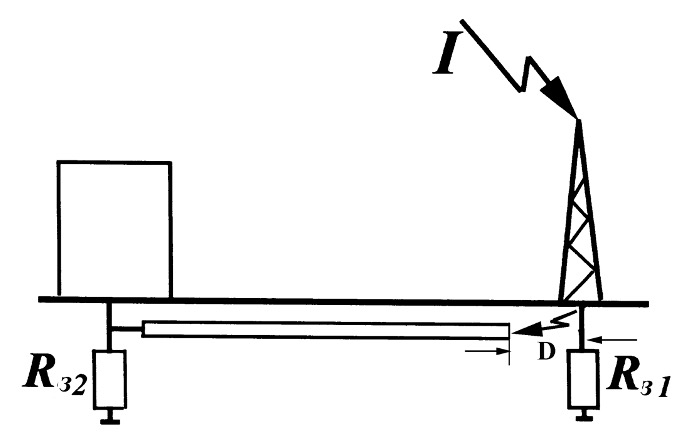
In the simplest case, the current distribution along the utility with a linear leak G is described by equations with local derivatives where you should also consider linear induction of utility L, and in high resistivity soils also its linear capacity C in the soil. The software solution of the task meets no problems for any lightning current pulse or any inclusion scheme for any resistances of the ground terminal.
To evaluate possible length of the current transportation, the provided charts show the results of computational calculation for the rated lightning current 10/350 mcs passing along the metal pipeline with the radius of 50 mm. The pipeline is located in the soil having the resistivity of ρ at the depth of 0.5 m
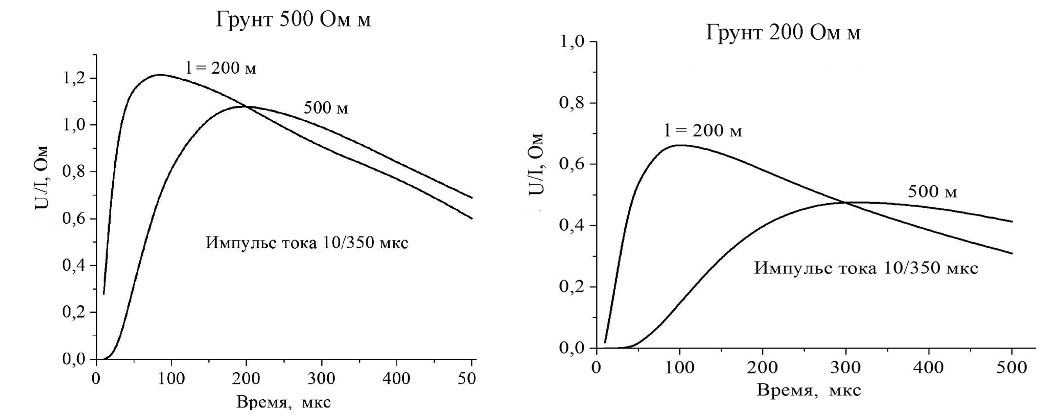
Ом - Ohm
Грунт 500 Ом м - Soil 500 Ohm m
Импульс тока 10/350 мкс - Current pulse 10/350 mcs
Время, мкс - Time, mcs
Грунт 200 Ом м - Soil 200 Ohm m
At its distant end, it is attached to the grounding arrangement with the grounding resistance of 4 Ohm which is typical for residential buildings. In order to determine the voltage transferred to the ground terminal, the calculated value on the chart should be multiplied by the magnitude of the lightning current IM. The values are impressive. Even at the utility length of 500 m, the building ground terminal voltage will be increased to U = 0,5IM kV, if IM is introduced in kA, i.e. up to 50 kV, upon the strike of the lightning with the rated current of 100 kA (lightning protection level III). And this is sufficient for good soil having soil resistivity ρ = 200 Ohm m. In a more high-resistance soil with ρ = 500 Ohm m, the surge will almost double.
I recommend reading regulatory documents to know about the regulatory protection means from high potential penetration. You can only find the particular information in Lightning Protection Guidelines RD 34.21.122-87. Its directions are brief and particular: the utility should be connected to the grounding arrangement of the protected facility. It was done like this in the calculation examples performed. Let me remind you that the surge at the grounding resistance of 4 Ohm was several dozens kV.
Yikes! What kind of protection is this? Such voltage increase at the grounding bus will probably damage all plugged-in modern electronic devices. Read the Guidelines one more time and note the final digits in its designation, i.e. 87. In 1987, we did not even dream of any household microprocessor equipment. The protection described in the Guidelines is the protection of human against high voltage. It is not about electronics. It surely needs protection. We have to discuss its means and methods particularly.
How can we do that?
Traditionally, to limit surges, the specialists first try to reduce the grounding resistance. This is a reasonable measure when we are talking about the surges caused by direct lightning strikes to the high-voltage power lines. But it is not efficient enough to protect the electronic equipment. For example, if we repeat the calculation for high potential penetration, the grounding resistance of the utility was reduced to 0.5 Ohm instead of 4 Ohm. As a result, the voltage at the ground terminal with the lightning current of 100 kA exceeded 20 kV, which is unacceptably high for modern electronics. Nevertheless, you should not forget the electrostatic interference, with the value that may be effectively limited to the safe level by using the grounding resistance, and they are really achievable for standard structures and in conventional soils.
To perform the valid evaluation, you should use the particular values of the linear charge of the downward lightning leader. Our team has estimated them by plotting this parameter τL against the lightning current magnitude. The average
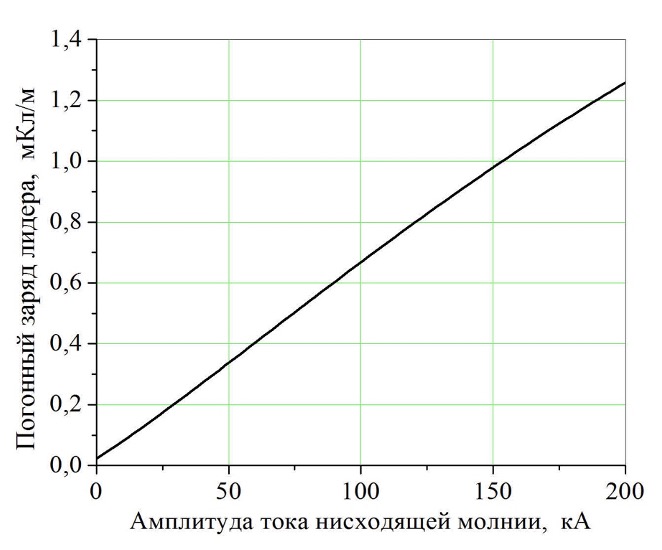
Погонный заряд лидера, мКл/м - Leader linear charge, mC/m
Амплитуда тока нисходящей молнии, А - Downward lightning current amplitude, A
lightning with the current of 30 kA conforms to the linear charge of 0.3 mC/m. The estimate will be performed for it. The lightning with this current that got into the ground or to the lightning arrester at the distance of r = 200 m from the facility will excite the electrical field at the ground surface.

All further operations will be entirely similar to the already made ones in the respective section of this article. At the building hem> =10 m high with the capacity of C = 1,000 pcF, this electrical field will induce the charge of
ΔQ = ΔhEC = ΔQ = 10 х 18000 х 10-9 = 0,00018 Кл.
With its neutralization within ~1 mcs, the current iЭ = 0,00018/10-6 = 180 А will flow along the facility's ground terminal thus increasing the voltage up to UE = iERG. If, e.g., the guaranteed electrical strength of the microelectronic equipment is equal to Uadd = 1,500 kV, the facility's grounding resistance should not exceed RG = 1500/180 ≈ 8 Ohm. A real danger exists with higher grounding resistance.
I think that some readers will accuse me of unacceptable forgetfulness and remind me that, in addition to own resistance, there is also the grounding resistance of the substation which is certainly not more than 4 Ohm. It will take a significant part of induced current through the wires. The reproach of this kind is beside the point. The distance to the substation grounding electrode is rather large. It may exceed, e.g. 150 m. The lightning "knows" about this additional grounding resistance when the electromagnetic wave with the velocity of 300 m/mcs will reach it and reflect to return back within just 1 mcs. During this time, the electrostatic interference pulse will reduce to almost zero. The help seems to be late and, therefore, useless.
I suppose that now, the reader expects me to mention the protection using SDPs. I will try to drag it out for some more. SDP is an efficient protection means but it is pretty expensive and unreliable. It must be integrated directly into the protected electrical circuit which is not always easy. The SDP may change the frequency characteristics of the circuit, reduce its reliability, and require additional switching elements. Finally, mass production of high-quality modern SDPs, unfortunately, has not yet been established in Russia. This is a high-tech production and the problem of import substitution is yet pressing. Therefore, it is more reasonable to first try to use traditional means. The more so, they are often cheap and affordable.
Thus, proper tracing of underground utilities is of crucial importance in case of high potential penetration. If we space them from the most probable lightning current entry to the ground, the task may be considered to be solved. Talking about electromagnetic interference, in addition to already considered approximation of the distance between the wires (using the SIP wire) and distribution of the lightning current among the maximum number of current collectors, it is also useful to note shielding of the electrical utilities. For this purpose, the utilities are placed to metal boxes, preferably with circular cross-section. This ensures the change in the interference level by at least an order of magnitude.
A way to introduce the voltage to the house directly is very important. Usually, it is l = 20–25 m from the nearest support to the 0.4 kV line. It is not an improbable situation when bare wires of the line were replaced to SIP, the line to the house was not actually replaced. It has remained the same with the distance between bare wires being about 0.4 m. Formula (1), working for this short section, demonstrates interference of about 3.6 kV with the lightning strike having a front steepness of Ai = 2х1011 A/s at the distance of 100 m from the line. This value is surely dangerous for modern electronic devices. To eliminate it, the voltage entry to the house from the nearest support should also be made with the SIP wire or shielded cable, and it is more reliable to do it using an underground cable.
Remember that the interference source is often provided by a single high-rise structure, most often antenna mast located in the industrial zone. You cannot remove this mast for technological considerations, and by taking lightning strikes it excites dangerous electromagnetic interference to all adjacent microelectronic devices. Indeed, you cannot remove the mast, but you can cover it from the lightning. The DAS protection system is designed for this. Its installation reduces the lightning strike frequency by folds. The frequency of interference of any origin reduces to the same extent. The use of DAS in practical lightning protection has already been considered in a separate ZANDZ webinar.
If the aforementioned conventional means do not help in any way, they are very expensive or they cannot be implemented, it is time to use SDPs. As noted above, their problem in the international market of the lightning protection means market is not very favorable. Fortunately, the requirements to protection against electromagnetic interference are not the toughest, because the lightning current by affecting here remotely does not flow directly through SDPs. For this reason, most practically significant situations allow avoiding the use of technologically challenging switching-type SDPs based on spark dischargers and are limited by the devices of a limiting type based on variable resistors. They are incomparably cheaper and they are available for sale without any limitations. It is important that the SDP triggering time based on variable resistors does not exceed 20 to 25 ns. Therefore, they efficiently reduce electromagnetic interference characterized by steep wavefront and low duration time. Note that the SDP selection method and recommendations for its installation have been discussed several times during the ZANDZ webinars and are available for repeated studies. The details of the required materials regarding this issue are summarized in the book titled "Electromagnetic Compatibility with the Lightning".
In conclusion, I would like to tell about my own losses from lightning, once again. We are not talking about the high potential penetration. In our street, water is transported via a plastic pipeline. The magnetic interference also has a low probability. The SIP wire was used along the entire path of the 0.4 kV line up to the entry to the house. Only the electrostatic interference remains. The house foundation is made of bricks and cannot play the role of the grounding arrangement. A special ground terminal is arranged nearby, which is recommended in the Guidelines RD 34.21.122-87, i.e. the 5 m horizontal bar with two 3 m vertical electrodes at the ends. All of them are located in the soil having soil resistivity of about 250 Ohm*m at the depth of 0.5 m. The electrical capacity of the house is defined primarily by its metal roof and is close to 1,000 pcF. The average roof height is 5 m. In these evaluation conditions similar to the above, the discharge induced as a result of the electrostatic induction is ΔQ = 5 х 105 х 10-9 = 0,0005 C. With its neutralization within about 10-6 , the pulse current of 500 A will be formed. Now, you have to estimate the grounding resistance of the installed ground terminal. The computer calculation shows that it is equal to
Rg = 0,126ρ Ohm
With resistivity of 250 Ohm*m, we obtain 31.5 Ohm. This is an unacceptably high value, since the current of 500 A creates the voltage of about 16 kV in such a ground terminal. It is a good thing that few devices were plugged in! There could have been more damage. But I couldn't reduce the grounding resistance in a small land plot. So, we have to rely on SDP.
Related Articles:
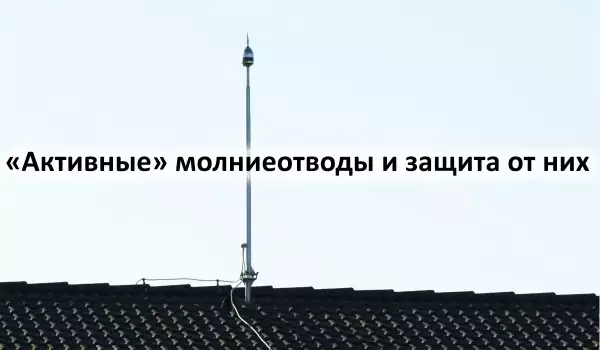 Webinar by Prof. E.M. Bazelyan Titled "Active" Lightning Arresters and Protection Against Them"
Webinar by Prof. E.M. Bazelyan Titled "Active" Lightning Arresters and Protection Against Them"
 Software Calculator for Calculating Interference from Lightning Current
Software Calculator for Calculating Interference from Lightning Current
 Methodics of calculation of SPD load currents
Methodics of calculation of SPD load currents

